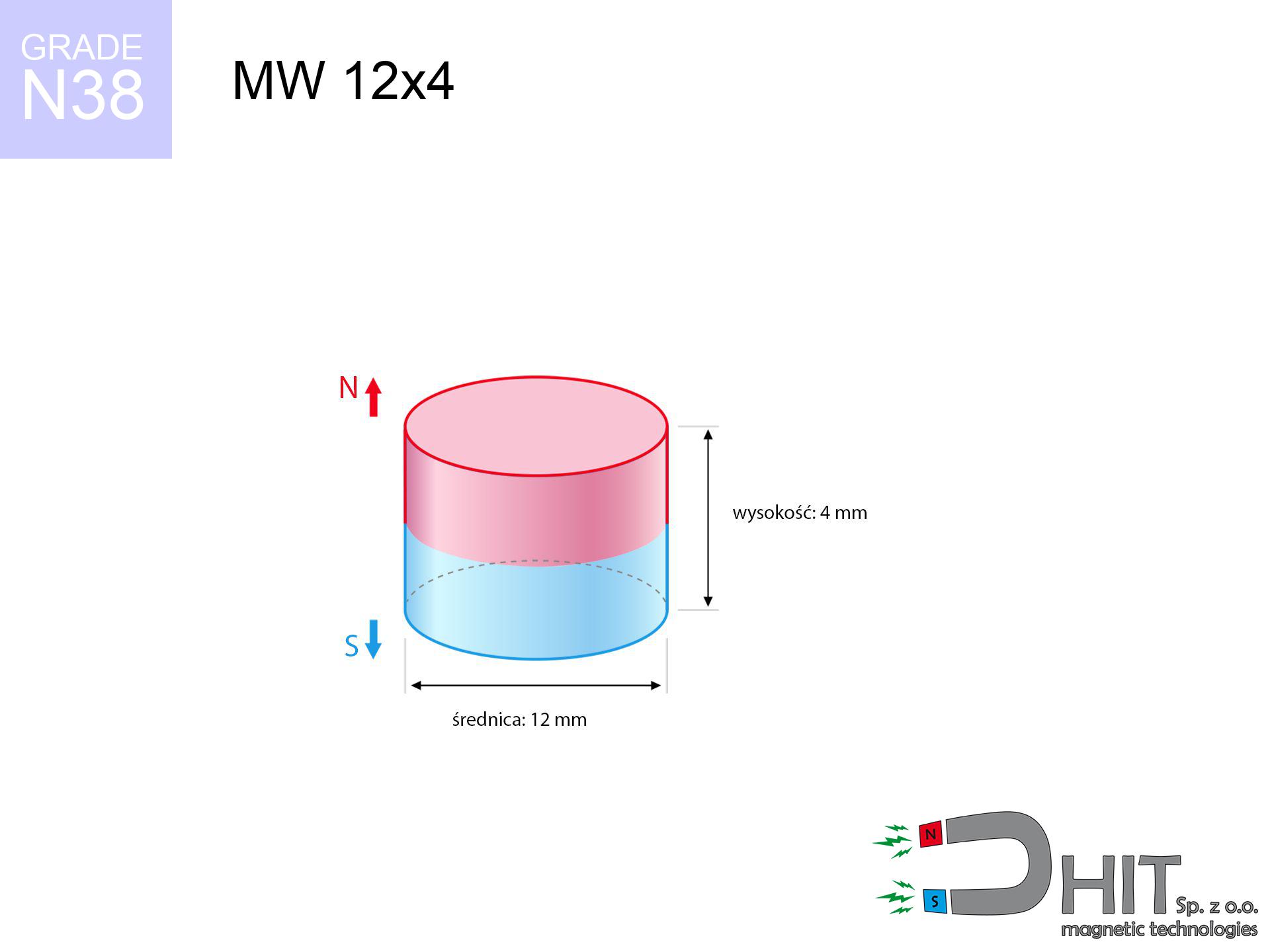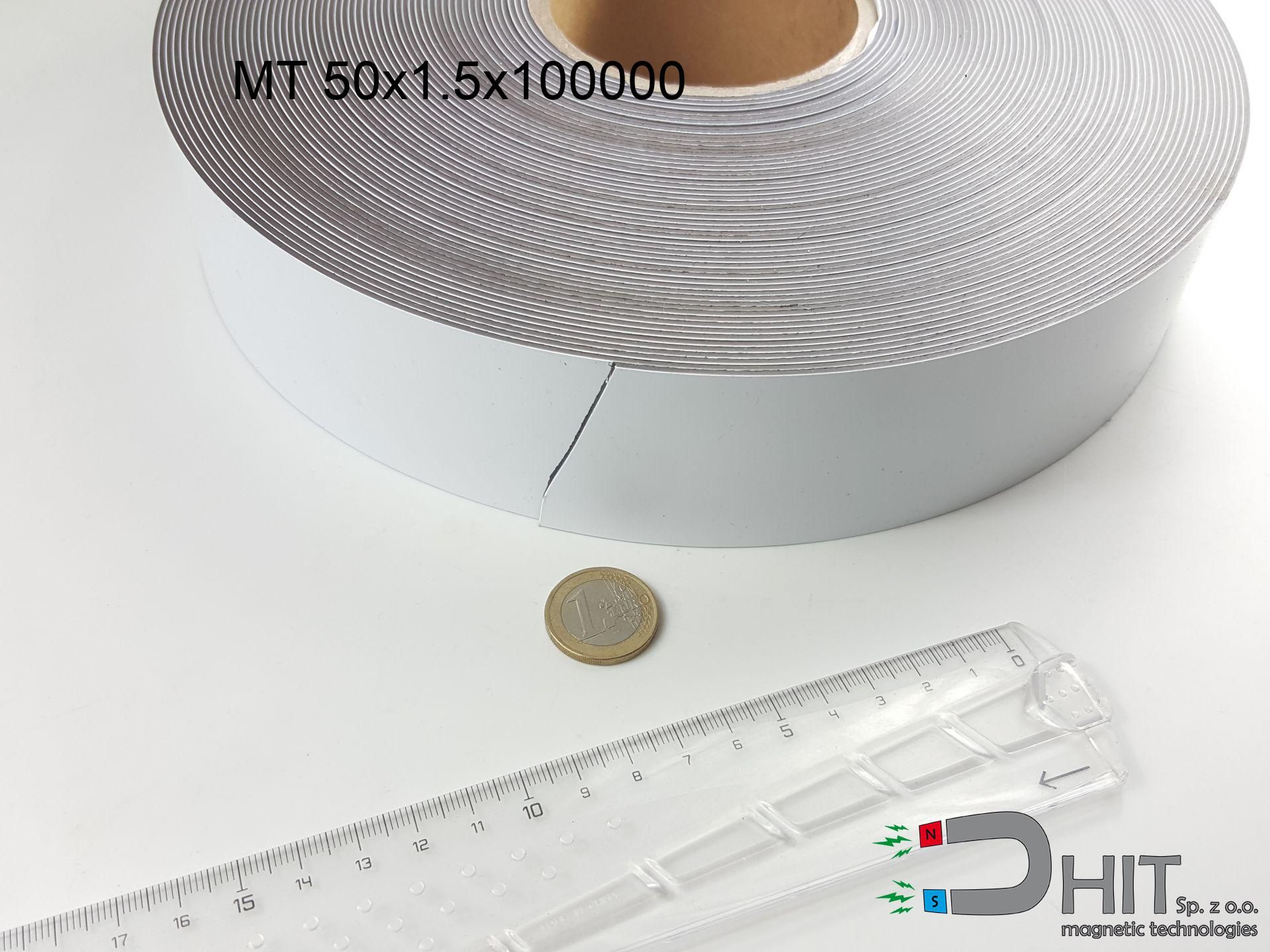MW 12x4 / N38 - cylindrical magnet
cylindrical magnet
Catalog no 010019
GTIN: 5906301810186
Diameter Ø [±0,1 mm]
12 mm
Height [±0,1 mm]
4 mm
Weight
3.39 g
Magnetization Direction
↑ axial
Load capacity
2.65 kg / 25.99 N
Magnetic Induction
343.64 mT
Coating
[NiCuNi] nickel
1.353 ZŁ with VAT / pcs + price for transport
1.100 ZŁ net + 23% VAT / pcs
1.070 ZŁ net was the lowest price in the last 30 days
bulk discounts:
Need more?Need help making a decision?
Call us now
+48 22 499 98 98
or contact us via
request form
the contact section.
Strength as well as form of magnetic components can be analyzed using our
our magnetic calculator.
Orders placed before 14:00 will be shipped the same business day.
MW 12x4 / N38 - cylindrical magnet
Magnetic properties of material N38
Physical properties of NdFeB
Shopping tips
Moreover, although neodymium is a component of the strongest magnets, they are susceptible to corrosion in humid environments. Therefore, they are coated with a coating of gold to increase their durability. Interestingly that NdFeB neodymium magnets are about 13% lighter than SmCo magnets and, despite their power, easily break, which requires care during their handling. Therefore, any mechanical processing should be done before they are magnetized.
In terms of safety, there are several recommendations regarding the use of these magnets. It is advisable to avoid their use in acidic, basic, organic environments or in solvents, and also in water or oil. Furthermore, they can damage data on magnetic cards and hard drives, although data deletion using a neodymium magnet is not guaranteed.
In terms of properties in different environments, neodymium magnets are sensitive to corrosion, especially in conditions of high humidity. Therefore, they are often coated with coatings, such as nickel, to preserve them from external factors and prolong their durability. Temperatures exceeding 130°C can result in a deterioration of their magnetic strength, although there are specific types of neodymium magnets that can tolerate temperatures up to 230°C.
As for dangers, it is important to avoid using neodymium magnets in acidic conditions, basic conditions, organic or solvent environments, unless they are properly protected. Additionally, their use is not recommended in wet conditions, oil, or in an atmosphere containing hydrogen, as they may lose their magnetic strength.
Advantages as well as disadvantages of neodymium magnets NdFeB.
In addition to their pulling strength, neodymium magnets provide the following advantages:
- They have stable power, and over around 10 years their attraction force decreases symbolically – ~1% (in testing),
- They remain magnetized despite exposure to magnetic noise,
- Thanks to the glossy finish and gold coating, they have an elegant appearance,
- They exhibit elevated levels of magnetic induction near the outer area of the magnet,
- With the right combination of materials, they reach significant thermal stability, enabling operation at or above 230°C (depending on the structure),
- With the option for customized forming and personalized design, these magnets can be produced in multiple shapes and sizes, greatly improving application potential,
- Wide application in modern technologies – they are used in data storage devices, electromechanical systems, medical equipment or even technologically developed systems,
- Thanks to their power density, small magnets offer high magnetic performance, in miniature format,
Disadvantages of magnetic elements:
- They are fragile when subjected to a heavy impact. If the magnets are exposed to mechanical hits, it is advisable to use in a protective case. The steel housing, in the form of a holder, protects the magnet from fracture while also increases its overall robustness,
- They lose power at high temperatures. Most neodymium magnets experience permanent loss in strength when heated above 80°C (depending on the dimensions and height). However, we offer special variants with high temperature resistance that can operate up to 230°C or higher,
- Due to corrosion risk in humid conditions, it is recommended to use sealed magnets made of protective material for outdoor use,
- Limited ability to create precision features in the magnet – the use of a external casing is recommended,
- Possible threat related to magnet particles may arise, especially if swallowed, which is significant in the family environments. It should also be noted that tiny components from these products can interfere with diagnostics once in the system,
- Due to a complex production process, their cost is relatively high,
Best holding force of the magnet in ideal parameters – what affects it?
The given strength of the magnet means the optimal strength, assessed in the best circumstances, namely:
- with the use of low-carbon steel plate acting as a magnetic yoke
- with a thickness of minimum 10 mm
- with a polished side
- in conditions of no clearance
- in a perpendicular direction of force
- at room temperature
Practical aspects of lifting capacity – factors
Practical lifting force is dependent on elements, by priority:
- Air gap between the magnet and the plate, because even a very small distance (e.g. 0.5 mm) can cause a drop in lifting force of up to 50%.
- Direction of applied force, because the maximum lifting capacity is achieved under perpendicular application. The force required to slide the magnet along the plate is usually several times lower.
- Thickness of the plate, as a plate that is too thin causes part of the magnetic flux not to be used and to remain wasted in the air.
- Material of the plate, because higher carbon content lowers holding force, while higher iron content increases it. The best choice is steel with high magnetic permeability and high saturation induction.
- Surface of the plate, because the more smooth and polished it is, the better the contact and consequently the greater the magnetic saturation.
- Operating temperature, since all permanent magnets have a negative temperature coefficient. This means that at high temperatures they are weaker, while at sub-zero temperatures they become slightly stronger.
* Lifting capacity testing was conducted on a smooth plate of suitable thickness, under a perpendicular pulling force, in contrast under attempts to slide the magnet the load capacity is reduced by as much as 5 times. Moreover, even a small distance {between} the magnet’s surface and the plate lowers the load capacity.
Exercise Caution with Neodymium Magnets
Avoid bringing neodymium magnets close to a phone or GPS.
Neodymium magnets generate strong magnetic fields that interfere with magnetometers and compasses used in navigation, as well as internal compasses of smartphones and GPS devices.
Neodymium magnets can become demagnetized at high temperatures.
Despite the general resilience of magnets, their ability to maintain their magnetic potency can be influenced by factors like the type of material used, the magnet's shape, and the intended purpose for which it is employed.
Dust and powder from neodymium magnets are flammable.
Do not attempt to drill into neodymium magnets. Mechanical processing is also not recommended. Once crushed into fine powder or dust, this material becomes highly flammable.
Neodymium magnets are the most powerful magnets ever invented. Their power can shock you.
Read the information on our website on how to properly utilize neodymium magnets and avoid significant harm to your body and unintentional damage to the magnets.
Neodymium Magnets can attract to each other due to their immense internal force, causing the skin and other body parts to get pinched and resulting in significant injuries.
Magnets will attract each other within a distance of several to around 10 cm from each other. Remember not to place fingers between magnets or in their path when attract. Magnets, depending on their size, are able even cut off a finger or alternatively there can be a severe pressure or a fracture.
Under no circumstances should neodymium magnets be placed near a computer HDD, TV, and wallet.
Strong magnetic fields emitted by neodymium magnets can destroy magnetic storage media such as floppy disks, credit cards, magnetic ID cards, cassette tapes, video tapes, or other devices. In addition, they can damage televisions, VCRs, computer monitors, and CRT displays. You should especially avoid placing neodymium magnets near electronic devices.
Neodymium magnets should not be near people with pacemakers.
In the case of neodymium magnets, there is a strong magnetic field. As a result, it interferes with the operation of a heart pacemaker. Even if the magnetic field does not affect the device, it can damage its components or deactivate the entire device.
Neodymium magnetic are extremely fragile, leading to shattering.
Neodymium magnets are characterized by considerable fragility. Neodymium magnetic are made of metal and coated with a shiny nickel, but they are not as durable as steel. At the moment of connection between the magnets, small metal fragments can be dispersed in different directions.
The magnet coating is made of nickel, so be cautious if you have an allergy.
Studies show a small percentage of people have allergies to certain metals, including nickel. An allergic reaction often manifests as skin redness and rash. If you have a nickel allergy, you can try wearing gloves or simply avoid direct contact with nickel-plated neodymium magnets.
Magnets are not toys, children should not play with them.
Neodymium magnets are not toys. Be cautious and make sure no child plays with them. They can be a significant choking hazard. If multiple magnets are swallowed, they can attract to each other through the intestinal walls, causing significant injuries, and even death.
Be careful!
To raise awareness of why neodymium magnets are so dangerous, see the article titled How dangerous are very powerful neodymium magnets?.






![UMGZ 60x30x15 [M10] GZ / N38 - magnetic holder external thread UMGZ 60x30x15 [M10] GZ / N38 - magnetic holder external thread](https://cdn3.dhit.pl/graphics/products/umgw-60x30x15-m10-gz-bas.jpg)


